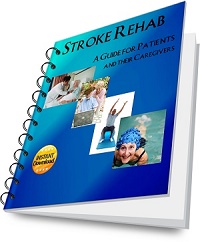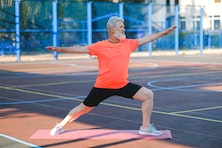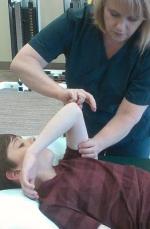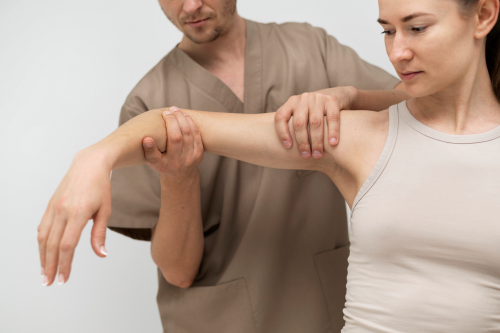Vision Problems Due to Stroke
Medically reviewed by Karen Murray, OT, CHT, CSRS - written by Stroke-rehab.com
Vision problems may occur after a stroke if an area of the brain that controls vision is affected. Below is a list of vision problems that one might experience due to stroke and various treatments that may be used.
Hemianopsia
Hemianopsia occurs when the visual field is cut in one-half of each eye. The person with hemianopsia will not see objects on the side where the visual field has been lost. Visual field is lost in one side of both eyes. Symptoms of hemianopsia may include only eating half of the food on one's plate, drawing only one side of an object, not being able to read one side of a page, and not seeing objects off to one side of the body. Patients with hemianopsia can be taught to compensate for their visual field loss by scanning their eyes in the direction of the hemianopsia and turning their head so they will not miss seeing objects on the affected side. Treatments for hemianopsia include saccade training or scanning therapy, boundary marking, lens that expand the visual field, and vision restoration therapy.
- Scanning Therapy - Saccades are rapid eye movements such as occur when the eyes move from one point to another in the visual field. Your eyes are constantly moving and use saccadic eye movement to take in bits and pieces of an object to create a whole picture for the brain. Scanning therapy or saccade training teaches a patient to scan toward the side of their hemianopsia. Saccades are often too short and slow in the patient with hemianopsia, and the patient has to be taught to scan further and faster with the eyes.
|
- Special lens - various lens have been developed to expand the visual field of a person with hemianopsia. These lenses include the EP Horizontal Lens, the Gottlieb Visual Field Awareness System, and the Chadwick Hemianopsia Lens.
- Visual Restoration Therapy is a computer-based treatment that attempts to stimulate existing visual neurons to rewire and make new connections. It is based on the premise of neuroplasticity. Some controversy has surrounded this technique, but it is approved by the FDA.
- Reading Focus Cards - There are cards that can isolate 1 or 2 lines of text and block out surrounding text. These can be used for books or e-readers. There are optional colored filters that can also help decrease the visual stress sometimes caused by white backgrounds. The colors of the filters can help unlock brain pathways for some struggling readers.
Diplopia
|
Diplopia or double vision can occur causing a person to see two images of a single object. Some treatment techniques include vision exercises, prisms, and occlusion (patching one eye or part of the lens). |
|
Visual Neglect
When visual neglect occurs, one will ignore objects off to one side of the body. Patients with visual field neglect often keep their head turned toward the non-affected side and rarely look over to the affected side. Helpful techniques for neglect include approaching and talking to the stroke victim from the affected side and encouraging scanning to that side. Teaching a stroke victim with neglect to scan to the affected side is more difficult than if they only have hemianopsia. Auditory feedback systems can be used to provide sound cues to help individuals with visual neglect direct their attention to the neglected side. For example, a device may emit a beep or tone, prompting the person to turn their attention in that direction.
Dry Eyes
|
The stroke patient may have a slowing of the blinking rate or an incomplete blink which leads to the eyes drying out. Artificial tears and reminding the patient to blink fully may be helpful for this condition. |
|
Sensitivity to Light
Sensitivity to Light - The eyes may have difficulty adjusting to different light levels. Sunglasses or tinted glasses may be helpful for this type of vision problem.
Convergence Insufficiency
|
With this eye disorder, the eyes do not turn in together (or converge) as they should when a person is looking at an object in midline near the face. You can test for convergence insufficiency by having a patient watch a pen as you move it toward their nose. In a normal response, both eyes should move inward as the pen moves closer to the face. Incoordination of the eye muscles due to stroke can lead to an abnormal response where one (or both) eyes do not move inward often causing double vision. |
A Brock String can be used for convergence training. |
Depth Perception
Stroke may affect the brain's ability to process depth cues, leading to problems with judging distances and perceiving depth accurately. This makes it difficult to tell how far or near an object is and may result in the patient under or overreaching when trying to grasp an object.
Vision Treatment
If you have visual perceptual deficits after stroke, you should seek out a specially trained optometrist called a neuro-optometrist. These professionals are trained in working with eye disorders after stroke or neurological injury. In addition, you can do vision rehabilitation with an OT trained in this area. There are also various activity books with visual perceptual activities like the ones below that can be found online:
|
|
|
|
Newsletter Sign Up
Receive Stroke Recovery Tips, our online quarterly newsletter. Sign up below for free tips on exercises, resources, latest technology, apps, research and more!
To view past issues of Stroke Recovery Tips, visit https://www.stroke-rehab.com/Stroke-Recovery-Tips-BackIssues.html
As an Amazon Associate I earn from qualifying purchases.
- Home
- Vision Problems
Recent Articles
-
How to Make Neuroplasticity Repeatable On Demand
Submission from reader: Neuroplasticity is widely touted as a way for stroke survivors to recover. To make it repeatable on demand, what exact signal is -
Only Plays Internet Games and Nothing Else Three Years Post Stroke
Question: I know playing games for up to 8 hours on the internet is not healthy for anyone. Does anyone know how sitting all day long playing games on -
Sadness After Stroke
I Get Sad Question:I get so sad at times like I lost the old me, I was very active and now I’m not, I’ve had a complete meltdown and just sobbed. Answer: -
More damage done to paralyzed left arm as a result of carelessness.
Question: My husband suffered a stroke which caused his entire left side with no feeling or movement. Recently, my husband possibly could have been turned -
Shouting, Confusion, and Anger After Stroke
Question from reader: My mom had a stroke about a month ago. Physically she is improving, but she has bouts of anger, confusion (says weird things), and -
Cloudy vision after stroke
Question: My mother had a stroke 1 yr ago. It caused partial loss of vision on her right side. During a 4 day road trip, her vision would get cloudy and -
Flaccid Paralysis After Stroke
Learn about stroke treatment for flaccid paralysis after stroke. -
Vision Problems After Stroke
Answers to patients' questions about vision problems after stroke and treatment. -
Symptoms Getting Worse After Stroke
If you experience sudden declines or changes after stroke, you should seek medical attention. -
Flaccid Paralysis Treatment After Stroke: Questions and Answers
Answers to questions about flaccid paralysis treatment after stroke including home exercises and treatment ideas.















